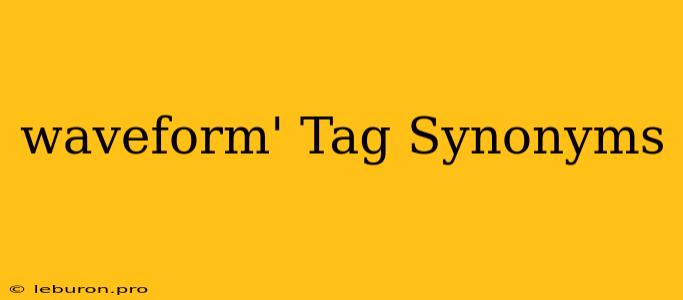Understanding Waveforms: A Comprehensive Guide to Visualizing Signals
Waveforms are graphical representations of how a signal changes over time. They are a fundamental concept in various fields, including electronics, audio engineering, and signal processing. Understanding waveforms is crucial for analyzing, interpreting, and manipulating signals effectively. In this comprehensive guide, we will explore the key aspects of waveforms, their significance, and how they are used in different applications.
What is a Waveform?
A waveform is a visual depiction of the variation of a signal's amplitude over time. It's essentially a graph where the horizontal axis represents time, and the vertical axis represents the signal's amplitude or value. The shape of the waveform reflects the characteristics of the signal, such as its frequency, amplitude, and phase.
Types of Waveforms
There are numerous types of waveforms, each with its unique characteristics and applications:
1. Sine Wave: The most fundamental waveform, characterized by a smooth, periodic oscillation. It is commonly found in AC power systems, sound waves, and electromagnetic radiation.
2. Square Wave: This waveform alternates between two distinct levels, forming a rectangular shape. It is used in digital electronics, clock signals, and musical synthesizers.
3. Triangle Wave: As its name suggests, this waveform has a triangular shape, rising linearly to a peak and then descending linearly back to its starting point. It is often found in electronic oscillators and signal generators.
4. Sawtooth Wave: This waveform resembles a sawtooth, with a linear rise and a sharp drop back to its starting point. It is employed in electronic music synthesis and video signal generation.
5. Pulse Wave: This waveform is characterized by a series of short, rectangular pulses with a defined duration and repetition rate. It is commonly used in digital communication and radar systems.
Key Properties of Waveforms
1. Amplitude: The maximum deviation of the waveform from its average value. It represents the strength or intensity of the signal.
2. Frequency: The number of cycles of the waveform that occur in one second. It determines the pitch of sound waves or the color of light waves.
3. Period: The time it takes for the waveform to complete one cycle. It is the reciprocal of frequency.
4. Phase: The position of the waveform relative to a reference point at a given time. It is measured in degrees or radians.
Applications of Waveforms
Waveforms play a vital role in various fields:
1. Electronics: Waveforms are fundamental to understanding and analyzing electronic circuits. They are used to represent voltage, current, and signal behavior.
2. Audio Engineering: In audio, waveforms are used to visualize sound signals, allowing audio engineers to analyze and manipulate sound quality.
3. Signal Processing: Waveforms are the building blocks of signal processing techniques, enabling the analysis, filtering, and manipulation of signals.
4. Telecommunications: Waveforms are essential for transmitting and receiving signals in communication systems, including radio, television, and mobile networks.
5. Medical Imaging: Waveforms are used in medical imaging techniques like ultrasound and electrocardiography to visualize physiological signals.
Analyzing and Interpreting Waveforms
Analyzing waveforms involves understanding their key properties and interpreting their shape. This can be done using specialized software or tools that provide various analysis features, such as:
1. Frequency Spectrum: This shows the distribution of different frequencies within a signal.
2. Time-Domain Analysis: This examines the waveform's behavior over time, identifying its amplitude, frequency, and other properties.
3. Correlation Analysis: This compares two waveforms to identify similarities or differences.
4. Statistical Analysis: This provides insights into the waveform's average values, standard deviations, and other statistical properties.
Conclusion
Waveforms are indispensable tools for visualizing and analyzing signals in various fields. By understanding the different types of waveforms, their key properties, and how they are used in applications, we gain a deeper understanding of the behavior and characteristics of signals. This knowledge is essential for effectively manipulating and interpreting signals in electronics, audio engineering, signal processing, and many other disciplines. Continued exploration of waveforms and their applications will continue to advance our understanding of signals and their impact on our world.
